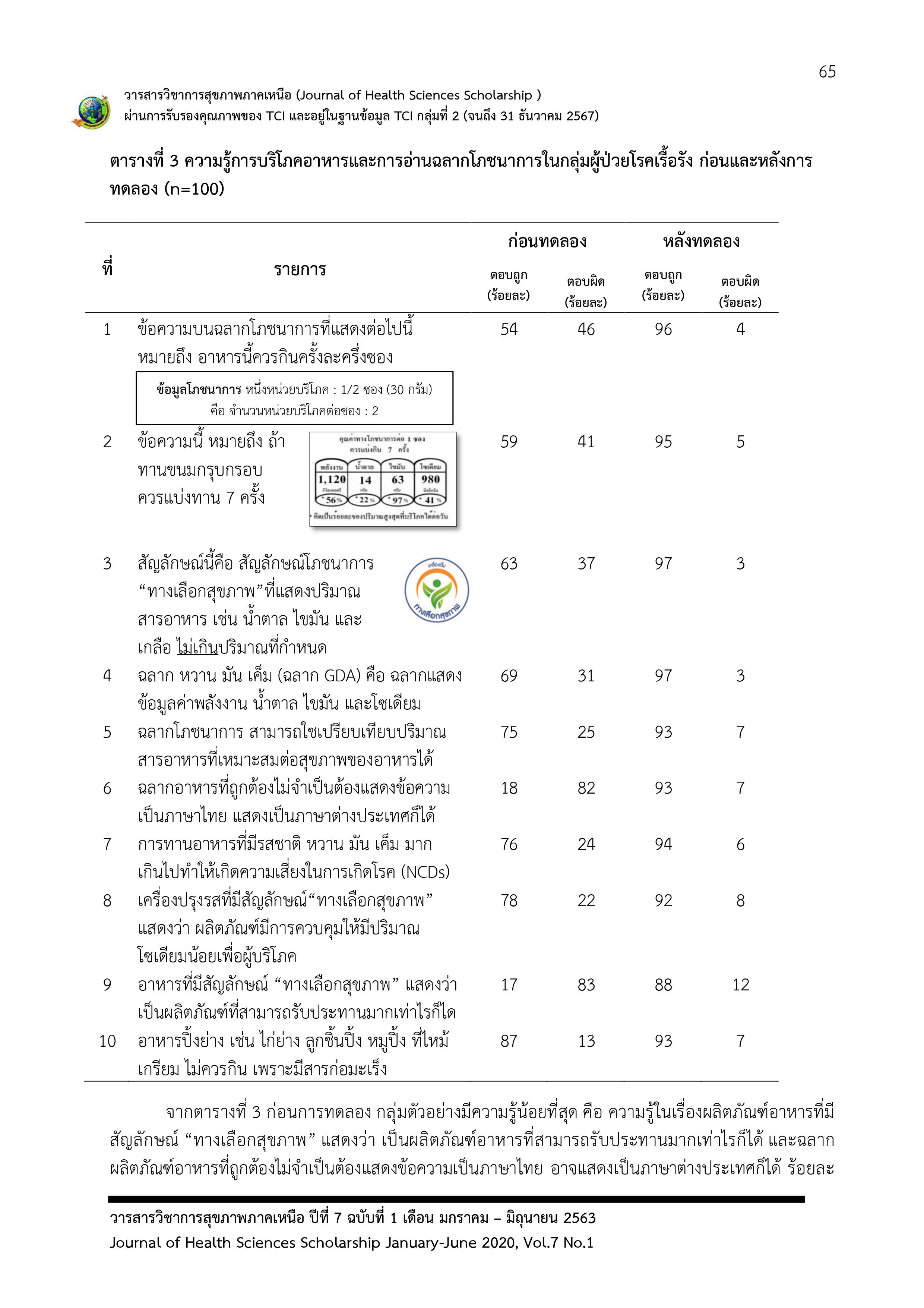การพัฒนาแนวทางการปรับเปลี่ยนพฤติกรรมการบริโภคอาหารและการอ่านฉลากโภชนาการในกลุ่มผู้ป่วยโรคเรื้อรัง ชุมชนบ้านป่าเหียง ตำบลบ่อแฮ้ว อำเภอเมือง จังหวัดลำปาง
คำสำคัญ:
การปรับเปลี่ยนพฤติกรรม, การบริโภคอาหาร, การอ่านฉลากโภชนาการบทคัดย่อ
การวิจัยครั้งนี้เป็นการวิจัยแบบผสมผสาน มีวัตถุประสงค์เพื่อพัฒนาแนวทางการปรับเปลี่ยนพฤติกรรมการป้องกันการเกิดโรคเรื้อรังในชุมชนและประเมินผลลัพธ์ของของการพัฒนา โดยดำเนินการ 3 ระยะ ได้แก่ ระยะที่ 1 วิเคราะห์สถานการณ์ที่เกี่ยวข้องกับปัญหาพฤติกรรมสุขภาพของผู้ป่วยเรื้อรังจากเวชระเบียนและสนทนากลุ่มกับทีมสุขภาพ ระยะที่ 2 การพัฒนาแนวทางทางการปรับเปลี่ยนพฤติกรรมการป้องกันการเกิดโรคเรื้อรังโดยการสัมภาษณ์เชิงลึกกับกลุ่มแกนนำในชุมชน จำนวน 20 คน และนำข้อมูลที่ได้มาเป็นแนวทางที่พัฒนาขึ้นไปใช้กับผู้ป่วยโรคเรื้อรัง ระยะที่ 3 การประเมินผลจากการใช้แนวทางและถอดบทเรียนการใช้แนวทางการพัฒนาในผู้ป่วยจำนวน 100 คน ด้วยแบบสอบถามความรู้และพฤติกรรมและถอดบทเรียนการพัฒนาแนวทาง เก็บข้อมูลโดยใช้แบบสอบถามและการทบทวนหลังปฏิบัติ วิเคราะห์ข้อมูลเชิงปริมาณโดยใช้ ร้อยละ ค่าเฉลี่ย ส่วนเบี่ยงเบนมาตรฐาน สถิติ Paired t-test และวิเคราะห์ข้อมูลเชิงคุณภาพด้วยการวิเคราะห์เชิงเนื้อหา
ผลการวิจัยพบว่า แนวทางการพัฒนา ได้แก่ 1) อบรมให้ความรู้โดยแบ่งเป็นฐาน 2) การสร้างแกนนำที่เข้มแข็งในการให้ความรู้และลงพื้นที่เยี่ยมบ้านติดตามการบริโภคอาหาร การอ่านฉลากโภชนาการที่ถูกต้อง 3) การมีหน่วยงานคุ้มครองผู้บริโภคในชุมชนที่ให้บริการแบบเชิงรุกและประชาสัมพันธ์อย่างต่อเนื่อง 4) การสร้างสิ่งแวดล้อมที่เอื้อต่อพฤติกรรมสุขภาพ และ 5) มีการใช้เทคโนโลยีตรวจสอบข้อมูลฉลากโภชนาการอาหารอย่างถูกต้องผ่านโทรศัพท์มือถือ หลังการใช้แนวทางพัฒนา พบว่า กลุ่มตัวอย่างมีคะแนนความรู้และพฤติกรรมการบริโภคอาหารและการอ่านฉลากโภชนาการหลังการพัฒนาสูงกว่าก่อนเข้าร่วมการอบรม อย่างมีนัยสำคัญทางสถิติที่ 0.5 ผลการถอดบทเรียน พบว่า แนวทางการปรับเปลี่ยนพฤติกรรมการการบริโภคอาหารและการอ่านฉลากโภชนาการในกลุ่มผู้ป่วยโรคเรื้อรัง ควรส่งเสริมให้ชุมชนมีส่วนร่วมในการกระตุ้นการปรับเปลี่ยนพฤติกรรมอย่างต่อเนื่อง การสร้างสิ่งแวดล้อมที่เอื้อต่อสุขภาพในพื้นที่ และการใช้เทคโนโลยีอย่างชาญฉลาดในการรู้เท่ากันฉลากโภชนาการอย่างถูกต้อง
เอกสารอ้างอิง
Aunprom-Me S..(2013). Important development of health promotion. Nonthaburi: Praboromarajchanok Institute, Ministry of Public Health. (in thai).
Ban Tha Khua Sub-district Health Promoting Hospital. (2018). Chronic disease patient data for the fiscal year 2017-2018. Lampang: Ban Tha Khua Sub-district Health Promoting Hospital. (in thai).
Bureau of Non Communicable Disease, Ministry of Public Health. (2018). Situation of Non-communicable Disease Prevention and Control Operations (NCDs).Nonthaburi: Department of Disease Control, Ministry of Public Health. (in thai).
Choeisuwan V.. (2017). Health Literacy: Concept and Application for Nursing Practice. Royal Thai Navy Medical Journal. 44(3), 183-197. (in thai).
ChorMai P. & Pranprawit A.. (2015). Effect of Health Promotion Program for Promoting Health Behavior Change in Groups at High Risk of High Blood Pressure at Bankhaodin Health Promotion Hospital, Khaopanom District, Krabi Province. Journal of Graduate School, Pitchayatat. 10(1), 15-24. (in Thai).
Cohen, J. (1977). Statistical power analysis for the behavioral sciences. (Rev. ed.). New York: Lawrence Erlbaum Associates, Inc.
Food and Drug Administration.(2016). Books to enhance consumption habits, Safe Food Project, Fiscal Year 2016. Bangkok: The Agricultural Cooperative Federation of Thailand. Limited.(in thai).
Food and Drug Administration. (2017). Handbook of health alternatives. Bangkok: The Agricultural Cooperative Federation of Thailand. Limited.(in thai).
Health Education Division, Department of Health Service Support, Ministry of Public Health. (2018).Strengthening and assessing health literacy and health behavior in Children and youth aged 7-14 years and people aged 15 and over. Nonthaburi: Ministry of Public Health.(in thai).
Kaewwannarat A..(2010). Methods of health education. Chiang Mai: Unity & Progress Solution Co.,Ltd. (in thai).
Kengganpanich M., & Kengganpanich T.. (2016).Health Promotion Strategies and Tobacco Control with Community Based Intervention. Journal of Health Education. 39 (133),1-10. (in thai).
Sa-ard S.. (2015). Development of Health Education Model Using by Self Directed Learning Media for Chronic Patients. Academic Services Journal Prince of Songkla University. 26(2), 41-49. (in thai).
Samnak N.. et al..(2011). Modification of Health Behavior in a Group of Patients with Pre-hypertension at the Pakphanang District, Nakhon Si Thammarat Province. KKU Journal for Public Health Research.4(2),21-28.
Seekao O.. (2015). Diabetes Management: Dimension of Disease and Nurse Role. Bangkok: M&M Laser Print. (in thai).
Songsilp S.. (2018). Prevalence of Food Products with Illegal Claims on the Labels Being Sold in Flea Markets at Loei. Thai Journal of Pharmacy Practice. 11(1), 151-159. (in thai).
Tanasugarn C.,& Neelapaichit N.. (2015). Development of knowledge tools for knowledge dissemination health (Health literacy) for patients with diabetes and hypertension. Nonthaburi: Health Education Division, Department of Health Service Support, Ministry of Public Health. (in thai).
Thai Health Promotion Foundation .(2018). Causes of death, chronic non-communicable diseases.[Online]. Available from: https://www.thaihealth.or.th/ NCDs.html. (2018, March, 15). (in thai).
Thammakrang S..(2017). Effects of Health Education with Experiential Learning Program on Attitude, Skill, Practice and Knowledge of GDA Nutrition Label Reading among Sixth Grade Students in Trang Municipality. Trang: Sirindhorn College of Public Health. (in thai).

ดาวน์โหลด
เผยแพร่แล้ว
ฉบับ
ประเภทบทความ
สัญญาอนุญาต
บทความ ข้อมูล เนื้อหา รูปภาพ ฯลฯ ที่ได้รับการตีพิมพ์ในวารสารวารสารวิชาการสุขภาพภาคเหนือ ถือเป็นลิขสิทธิ์ของวารสารวารสารวิชาการสุขภาพภาคเหนือ หากบุคคลหรือหน่วยงานใดต้องการนำทั้งหมดหรือส่วนหนึ่งส่วนใดไปเผยแพร่ต่อหรือเพื่อกระทำการใดๆ จะต้องได้รับอนุญาตเป็นลายลักอักษรจากวารสารวารสารวิชาการสุขภาพภาคเหนือก่อนเท่านั้น
เนื้อหาและข้อมูลในบทความที่ลงตีพิมพ์ในวารสารวิชาการสุขภาพภาคเหนือถือเป็นข้อคิดเห็นและความรับผิดชอบของผู้เขียนบทความโดยตรงซึ่งกองบรรณาธิการวารสาร ไม่จำเป็นต้องเห็นด้วย หรือร่วมรับผิดชอบใดๆ
อนึ่ง ข้อความและข้อคิดเห็นต่างๆ เป็นของผู้เขียนบทความนั้นๆ ไม่ถือเป็นความเห็นของวารสารฯ และวารสารฯ ไม่จำเป็นต้องเห็นด้วยกับข้อความและข้อคิดเห็นใดๆ ของผู้เขียน วารสารฯ ขอสงวนสิทธิ์ในการพิจารณาตีพิมพ์ตามความเหมาะสม รวมทั้งการตรวจทานแก้ไขหรือขัดเกลาภาษาให้ถูกต้องตามเกณฑ์ที่กำหนด


